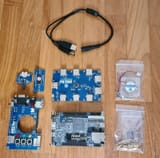>>11954837
>There seems to be *way* too many options to even understand where to start.
Not really, it's all more or less the same thing, just generally in a different layout.
Most are all build around a Terasic DE-10 Nano board:
https://www.terasic.com.tw/cgi-bin/page/archive.pl?Language=English&CategoryNo=167&No=1046
That's the board you see in the middle of your image.
Technically all you need is that board and the software on a MicroSD card, though many of the cores require a SDRAM module to work (You can see that plugged into the left of the DE-10 in your image), but with the DE-10 and a RAM module alone you can run all MiSTer cores and games on them.
Others have seen made their own versions of the DE-10 board for cheaper, such as QM Tech and Taki. (Personally I don't recommend QM Tech since they changed some stuff around that breaks compatibility with other's accessories)
The rest are technically optional depending on if you want to make it more convenient to use, have more features, or connect it to an analog display.
The board on the bottom is a USB hub, not much different from any a hub you might pick up from an electronics store, it's just made to fit exactly with the DE-10 under it (And in Taki's version, it has a header that it plugs directly unto underneath the DE-10 so you don't need to use a coupler to connect it). The board on the top is usually an Analog I/O board, it allows you to output analog signals like VGA, composite, component, RGB, s-video, etc as well as a place to install a cooling fan, has a few buttons for ease of use, and contains the user/SNAC port. There is a Digital I/O board too but practically nobody uses those, they are fairly useless (The DE-10 already has HDMI built in). Technically, there IS a way to get analog out of the HDMI port and not need an Analog I/O board, but it has it's own list of cons going that route and you lose the user port/fan.
Adding a $5 USB WiFi/Bluetooth is also commonly recommended.
(continued)
